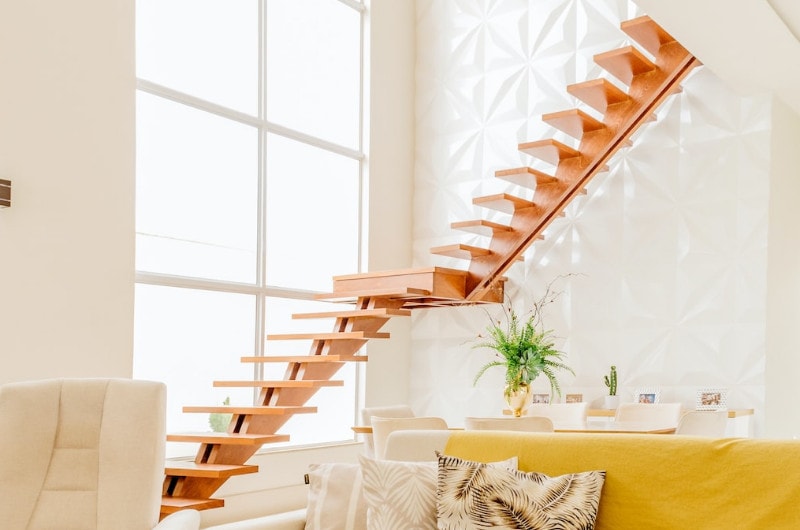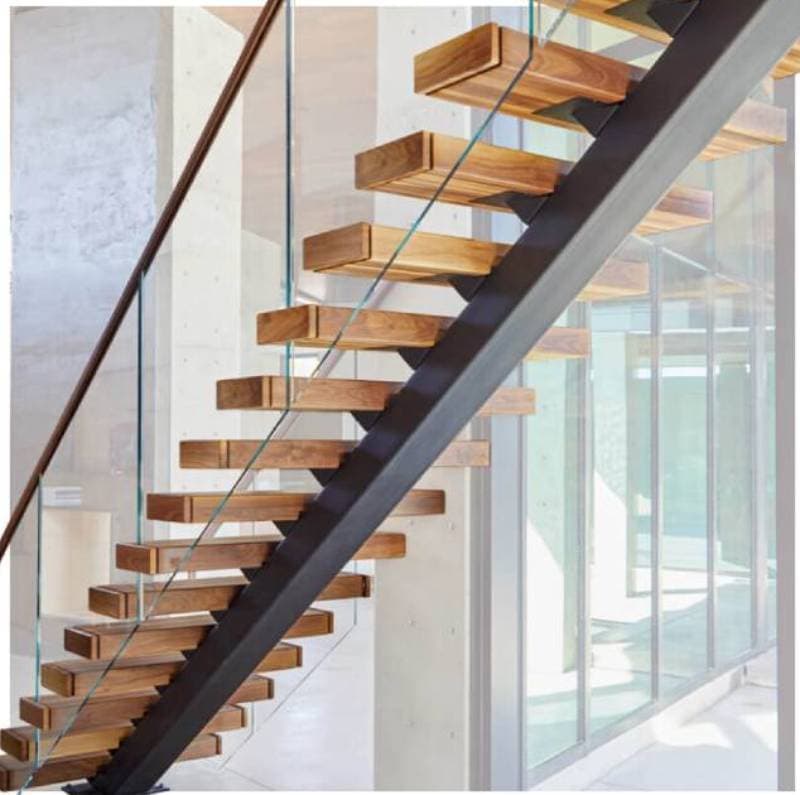3 DIY Floating Stairs You Can Construct Today (With Pictures)
-
Pete Ortiz
- Last updated:

Floating staircases are a type of straight stairs designed without any visible support columns to appear like they are magically suspended in mid-air. These iconic stairs differ from traditional staircases in that specially engineered mounting options are used to support them. The mounting kits are usually small to disappear into the wall, but they are sturdy as they obtain more structural support from a stringer. A stringer is a long metallic tubing or wooden frame that runs in the middle or either side of a flight of stairs to where treads and raisers are attached to. The stringer’s main purpose is to provide a load-bearing framework.
Floating stairs are synonymous with stylishness and open up a lot of space. If you are considering installing floating stairs, you are in the right place.
The 3 DIY Floating Stairs Plans
1. Mono Stringer Floating Stairs

| Materials: | 4×8 wooden frames or steel or aluminum frames, 6x2s, screws, 2x4s |
| Tools: | Power drill, belt sander, table saw, wood-cutting saw with carbide-tipped blades, tape measure, laser or spirit level, a hammer, a screwdriver, and tempered glass |
| Difficulty Level: | Moderate |
Mono stringer floating stairs are one of the easiest stair sets for DIYers to install using locally available materials and basic knowledge within the shortest time. The design features a single stringer running in the middle. The stringers can be metallic or wooden, but most people prefer carbon steel or aluminum to other materials because it is strong enough to support the combined weight of other parts of the stairs and those who will be using them. If you choose to go with wood, hardwood is the best. These stringers are best when paired up with lightweight pressure treated 6×2 stair treads and raisers.
If you have some 2x4s lying around, feel free to use them as handrails or banisters.
Lastly, with a power drill set, saws, and hammer, you can get this staircase up and running without consulting an expert. However, ensure you are using the strongest materials possible.
2. Floating Stairs With a Landing

| Materials: | 4×8 wooden frames or steel or aluminum frames, 6x1s, screws, 2x4s |
| Tools: | Power drill, belt sander, table saw, wood-cutting saw with carbide-tipped blades, tape measure, a laser or spirit level, a hammer, screwdriver, and tempered glass or your favorite handrail material |
| Difficulty Level: | Moderate |
A landing/deck is a wide platform made from the same materials as stairs provided at the top or bottom of every flight. A landing on floating stairs may be for functional or decorative use.
For functional uses, the landing forms a wider platform that is safe to stand on while exiting a flight of stairs. If it is located in the middle of two flights, it signifies that stairs are changing in direction, especially on zig-zag staircases.
The landing may also be used to add decorative elements to the staircases by breaking the silent monotony of long flights.
Even though floating stairs with landings can be a mono or double stringer, they need special attention. For example, the width of the landing should be at least two times that of a tread in half space landing design. In contrast, if flights are running at right angles to each other, they will be separated by a square landing (full space landing), meaning its width is equal to the length of the staircases.
Also, don’t forget to bolster the landing with more support.
3. Cantilever Stairs

| Materials: | 4×8 wooden frames or steel or aluminum frames, 6x1s, screws, 2x4s |
| Tools: | Power drill, belt sander, table saw, wood-cutting saw with carbide-tipped blades, tape measure, laser or spirit level, a hammer, and a screwdriver |
| Difficulty Level: | High |
Cantilever staircases are the perfect definition of floating stairs with just one or, in most cases, without any stringer, which makes it one of the classiest staircase trends.
The easy-to-design flight takes advantage of existing structures, such as walls which will form the support. One end of the tread will be embedded into the wall, with the other floating out freely.
If you are using the wall as a stringer, ensure it is stable enough to support the combined weight of the tread and yours; otherwise, provide extra support. You can use a wooden string beam bolted into the wall or with hidden supports anchored from the ground.
Because cantilevers avoid the use of balusters, some people are skeptical about their safety. Unless you have young kids who are at risk of injuring themselves, you may attach railings on the wall to hold onto as you climb up.
Another way to mitigate this accident risk is to build a wider flight.
Conclusion
As a DIYer, there are so many floating stair projects you can design and bring to life. Mono and double-stringer floating stairs are almost identical, employing locally available resources and basic knowledge. Floating stairs with a landing are a little bit difficult to construct since the platform requires special attention to ensure it is well-secured in place.
As a rule of thumb, whatever floating stair project you choose to go with, security is paramount. Use balusters and your favorite choice of handrails. If you choose to construct cantilevers, let the handrail be part of the wall.
Featured Image Credit: Jonathan Borba, Unsplash
Contents


